The Kyoto Imperial Palace stands as a timeless symbol of Japan’s imperial heritage and aristocratic elegance. Once the residence of emperors for over a millennium, this graceful and grand structure offers a glimpse into the refined world of court life, tradition, and architectural beauty.
Walking through the palace grounds feels like stepping back in time. The delicate wooden gates, wide gravel paths, and serene gardens transport you to an era of elegance and ceremony. In this guide, you’ll uncover what makes the Kyoto Imperial Palace a gem among Kyoto’s many treasures—from historical stories to tips on making the most of your visit.
Why Visit? A Regal Must-See in Kyoto
The Kyoto Imperial Palace isn’t just another historic site—it’s the beating heart of Japan’s imperial history. Before Tokyo rose as the capital, Kyoto was the center of the nation’s spiritual, political, and artistic life. Today, the palace remains a preserved sanctuary of this heritage. Its open, expansive grounds, beautifully maintained buildings, and traditional gardens invite travelers to experience a quieter, more contemplative side of Japan.
This guide will help you explore the palace like a seasoned traveler—learning the stories behind the walls, knowing what to look for, and appreciating every corner with new eyes.
History Woven Through the Ages
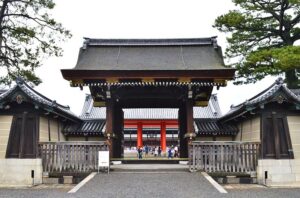
Photo from wikimedia.org
To truly appreciate its grandeur, it’s essential to understand its origins and the significant role it played throughout the centuries.
Where It All Began: The Origins of Kyoto Imperial Palace
The Kyoto Imperial Palace, or Kyoto Gosho, dates back to the Heian Period when Kyoto became the imperial capital in 794. For centuries, it served as the home of emperors and the heart of Japanese politics, literature, and ceremony. Although it has been rebuilt multiple times due to fires, each restoration preserved its historical layout, ensuring that the spirit of ancient Kyoto remains alive today.
A New Chapter: From Kyoto to Tokyo
In 1869, Japan’s capital and the imperial residence were officially moved to Tokyo during the Meiji Restoration. While the emperor no longer resides in Kyoto, the palace has been carefully maintained, symbolizing Japan’s enduring reverence for tradition. Today, it remains an important ceremonial site and a cultural treasure for the nation.
Preserving the Past: Restoration and Care
Unlike many historical sites, the Kyoto Imperial Palace has been meticulously restored under the care of the Imperial Household Agency. These efforts ensure authenticity in architectural design, materials, and layout, allowing visitors to walk through a space that closely resembles its original grandeur.
Built to Impress: Imperial Design and Architecture
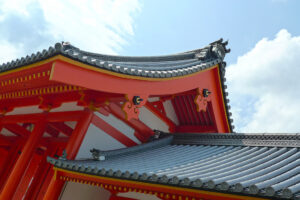
Photo from https://fng.or.jp
The Kyoto Imperial Palace showcases the elegance of traditional Japanese architecture, particularly the shinden-zukuri style, which emphasizes open spaces and natural light. Its elevated wooden floors, wide hallways, and flowing floor plans were designed to allow for graceful movement and to reflect the harmony between the structure and its surrounding nature.
Central to the palace’s design are its sweeping roofs, often adorned with intricate, yet simple, decorative elements. These roofs, paired with painted fusuma (sliding doors), create a sense of fluidity and lightness. Every structure within the palace grounds serves a dual purpose: to convey both aesthetic beauty and practical function. The gates, such as the Kenreimon, stand as monumental thresholds, while the design of each building is carefully planned to symbolize imperial power and serenity. Together, these elements create an atmosphere of quiet majesty, perfectly aligned with Japan’s cultural ideals of balance and grace.
Unveiling the Imperial Grounds: What to See at the Palace
As you explore the Kyoto Imperial Palace, you’ll quickly discover that its beauty isn’t confined to just its architecture; it extends to every corner of the grounds, every detail in the design, and every tree in the garden. From the grand ceremonial halls to the serene gardens, each part of the palace tells a story of imperial tradition and cultural significance. Here’s a closer look at what you can expect to see and experience during your visit.
The Heart of the Palace: Main Grounds and Halls
As you step into the Kyoto Imperial Palace, you’ll immediately notice its well-organized layout—everything within the complex follows a symmetrical and purposeful design. This is not only an aesthetic choice but a reflection of the imperial order and discipline that shaped court life for centuries. The Shishinden, or Hall for State Ceremonies, is the palace’s centerpiece, where important events such as enthronements, weddings, and New Year’s Day ceremonies took place. Its grand, open space and finely crafted beams evoke both regality and solemnity. Another notable structure is the Seiryoden, the former residence of the emperor. Here, you’ll find a beautiful blend of practicality and elegance, with finely crafted interiors that offer insight into the lifestyle of the imperial family.
Nature’s Touch: Gardens and Seasonal Deligh
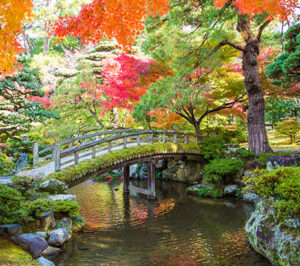
Photo from japantravelmate.com
Encircling the palace is the expansive Kyoto Gyoen National Garden, a lush park that adds a natural dimension to the palace’s architectural beauty. The garden features wide open lawns, tranquil ponds, and groves of plum and cherry trees, which change dramatically with the seasons. In spring, the garden bursts into color with soft pink cherry blossoms, while autumn transforms the landscape with rich, fiery hues of red and gold leaves. This ever-changing beauty not only enhances the atmosphere but also encourages visitors to slow down, relax, and connect with nature as they wander the paths of the garden.
Architectural Details to Admire
The palace’s architecture is a testament to the grace and simplicity of traditional Japanese design. Keep an eye out for the shoji paper screens, sliding doors, and wide tatami-floored rooms that create a sense of openness and calm. These features are designed to emphasize harmony with nature, allowing light to filter through the paper screens, casting soft shadows on the floors. The intricate craftsmanship extends to the palace gates, like the Kenreimon, a grand entrance with symbolic carvings that speak to the power and history of the imperial family. As you pass through these gates, you’re not just entering a building, but stepping into a living symbol of Japan’s past.
Symbols of Power and Tradition: Cultural Elements
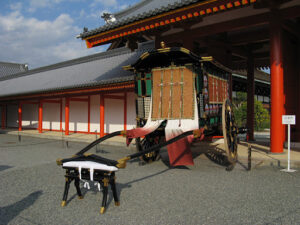
Photo from googleusercontent.com
Every detail of the palace was carefully considered to represent imperial power, tradition, and harmony with the natural world. The placement of trees, the orientation of halls, and even the layout of the gardens were all done with deep thought and symbolism in mind. For instance, certain trees and plants were chosen not only for their beauty but for their role in imperial ceremonies.
The Shishinden is positioned to face a specific direction in alignment with astrological beliefs, ensuring that the emperor’s ceremonies would align with the natural forces. The palace, thus, was more than a residence; it was a space where Japan’s oldest rituals were performed and preserved, a testament to the nation’s enduring respect for tradition and cultural heritage.
How to Visit: Practical Info for a Smooth Royal Adventure
Address: 3 Kyotogyoen, Kamigyo Ward, Kyoto, 602-0881, Japan
Phone: 075-211-1215
Website: kyoto-gosho.kunaicho.go.jp/en
Admission: Free
Opening Hours: Tuesday to Sunday, 9:00 AM to 5:00 PM
Closed: Mondays, December 28 to January 4
Getting There: Find Your Way to the Palace
- By Train: Take the Karasuma Subway Line to Imadegawa Station (Exit 3). The palace is a short walk from there.
- By Bus: Several Kyoto City Buses stop at Karasuma Imadegawa or Furitsu Idai Byoin-mae.
- By Car: Public parking is available nearby, but limited. Walking or public transit is recommended.
- By Bicycle or Foot: Kyoto is bike-friendly, and the Gyoen Garden has bike paths leading to the palace area.
Plan Your Visit: Opening Hours and Entry
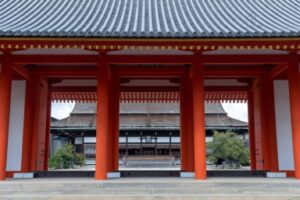
Photo from kyoto-gosho.kunaicho.go.jp
Entrance is free, and registration is no longer required for self-guided tours. However, if you want a deeper understanding, guided tours are available in both Japanese and English at scheduled times. These tours are informative and bring life to the palace’s history and architecture.
Best Times to Visit: When Beauty Blooms
- Late March to early April – Cherry blossoms in full bloom
The palace gardens come alive with cherry blossoms, creating a stunning pink canopy and offering the quintessential spring experience. - Mid to late November – Stunning autumn colors in the gardens
The gardens are transformed with vibrant autumn foliage, making it a peaceful time to explore the palace grounds. - Morning (around 9–10 AM) – Soft light and fewer crowds
Visit early to enjoy the serene atmosphere and capture the soft morning light on the palace’s architecture with fewer visitors. - Late afternoon (after 3 PM) – Golden-hour glow
The late afternoon provides a peaceful, golden-hour glow perfect for photography and a quiet, reflective experience.
7 Insider Tips: Making the Most of Your Visit
- Tour Like a Pro: Registration Details : Guided tours provide more insights. You can register in advance online or inquire on-site. English tours are available daily, but they can fill up quickly.
- Access with Ease: Helpful Info for All Travelers : The grounds are flat and accessible with wide gravel paths. Some interior areas have steps, so check ahead for mobility support.
- Respect the Grounds: Courteous and Conscious Travel : Keep noise to a minimum, stick to paths, and avoid touching structures. Photography is allowed outdoors, but check for indoor restrictions.
- Plan Your Visit: Visit early or late in the day for fewer crowds and better light for photos.
- Dress Comfortably : Wear comfortable shoes for walking, and dress appropriately for the weather. Modest attire is recommended.
- Know Before You Go: Entry Info : Admission is free, but certain areas may require registration or guided tours. Check ahead for details.
- Respect the Traditions: Be mindful of the palace’s cultural significance. Keep noise levels low and be respectful throughout your visit.
3 Nearby Attractions Worth Exploring
After exploring the Kyoto Imperial Palace, there are several nearby attractions that are well worth your time. Each offers a unique glimpse into Kyoto’s rich history, culture, and natural beauty. Whether you’re interested in historical sites, cultural experiences, or peaceful gardens, these destinations provide the perfect complement to your visit to the palace. Here are a few highlights within walking distance or a short bus ride from the Imperial Palace:
1. Nijo Castle – ~10 minutes by bus
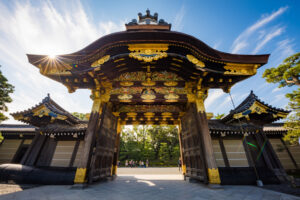
Photo from www.travelcaffeine.com
Just a short bus ride away, Nijo Castle is a UNESCO World Heritage Site that offers a fascinating glimpse into Japan’s feudal past. Famous for its “nightingale floors,” which chirp like birds when walked upon, the castle is a masterpiece of Japanese architecture and design. Its stunning gardens and well-preserved interiors make it a must-see, reflecting the power and grandeur of the Tokugawa shogunate.
Planning to Visit? More information below:
- Address: 541 Nijojocho, Nakagyo Ward, Kyoto, 604-8301, Japan
- Phone: 075-841-0096
- Website: https://nijo-jocastle.city.kyoto.lg.jp/
- Business Hours: 8:45am – 4pm (closes at 5pm)
- Closed Days: Year-end December 29th to 31st
- Admission Fee : Depends on where you will go within the palace
Kyoto International Manga Museum – ~15 minutes on foot
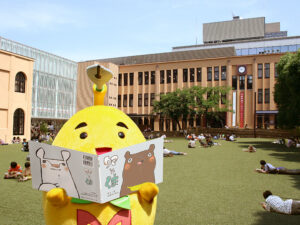
Photo from kyoto.travel
A 15-minute walk from the Imperial Palace, the Kyoto International Manga Museum is a vibrant, interactive destination for manga fans. Housing over 300,000 manga volumes, this museum allows visitors to browse its extensive collection and learn about the history and impact of manga in Japanese culture. It’s an enjoyable experience for both manga enthusiasts and those looking to explore a unique side of modern Japanese culture.
Planning to Visit? More information below:
- Address: 452 Kinbukicho, Nakagyo Ward, Kyoto, 604-0846, Japan
- Phone: 075-254-7414
- Website: https://kyotomm.jp/
- Business Hours: 10:00 AM to 5:00 PM (last admission at 4:30 PM)
Please note that operating hours and closure dates are subject to change.
3. Rozan-ji Temple – ~10-minute walk
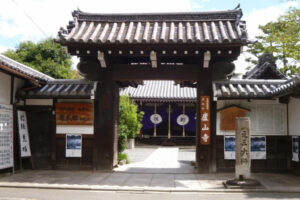
Photo from www.leafkyoto.net
Located just a 10-minute walk from the palace, Rozan-ji Temple is a peaceful and historic spot. Known for its tranquil gardens and beautiful Zen-style architecture, it provides a quiet retreat from the more crowded areas of Kyoto. The temple is a great place to reflect and enjoy the simplicity and beauty of traditional Japanese garden design.
Planning to Visit? More information below:
- Address: 397 Kitanobecho, Kamigyo Ward, Kyoto, 602-0852, Japan
- Phone: 075-231-0355
- Admission Fee: ¥500 for adults, ¥400 for children (elementary and junior high school students), and ¥400 per person for groups of 30 or more. Visitors with disabilities can enter for ¥400 with valid identification.
- Website: https://www7a.biglobe.ne.jp/~rozanji/
- Business Hours: 9:00 AM to 4:00 PM (January 1 and February 1–9)
Flavors to Savor: Foods to Try Nearby
Kyoto offers a range of delectable dishes that reflect its rich culinary traditions. Whether you’re craving a sweet treat or a savory delight, the following dishes are essential to try during your visit. Here’s a guide to the must-try foods around the Kyoto Imperial Palace and tips on how best to enjoy them:
| Dish | What It Is | How to Best Eat It |
| Yatsuhashi | Traditional Kyoto cinnamon rice crackers | Enjoy the crisp version with a cup of green tea, or snack on the soft version filled with red bean paste. |
| Nishin Soba | Buckwheat noodles topped with sweet herring | Best enjoyed with a dash of wasabi or pickled ginger to balance the rich flavor of the fish. |
| Matcha Parfait | Green tea parfait with jelly, mochi, and red bean | Savor each layer slowly, and pair with a warm cup of matcha for a perfect balance of flavors. |
| Tofu Cuisine | Delicate, seasonal tofu dishes common in Kyoto | Try yudofu (hot tofu) with a light soy-based sauce and fresh condiments like scallions or daikon. |
| Kyo-Kaiseki | Refined multi-course Kyoto meal emphasizing seasonal ingredients and presentation | Take your time with each course, appreciating the presentation and subtle flavors of each dish. |
Final Thoughts: Let the Past Embrace You
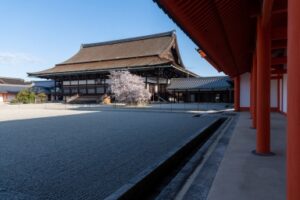
Photo from kyoto-gosho.kunaicho.go.jp
Visiting the Kyoto Imperial Palace is a journey into Japan’s imperial past, where every corner of the palace invites reflection and tranquility. It’s not just about exploring the structures; it’s about absorbing the atmosphere—feeling the calm rhythm of a place that has witnessed centuries of history. The graceful architecture, the quiet gardens, and the simple elegance of the grounds all combine to create a serene experience that is both grounding and awe-inspiring.
Take your time as you wander through the palace, allowing yourself to connect with the space. Appreciate the harmony between nature and design, and let the peacefulness of the environment settle over you. Remember that places like the Kyoto Imperial Palace are not just historical landmarks; they are living symbols of Japan’s cultural heritage. As you leave, carry with you a deeper understanding of how beauty and history are preserved through the ages—something that we must all cherish and protect.
Frequently Asked Questions (FAQs)
Are there guided tours?
Yes, guided tours are available in English and Japanese.
Is the Kyoto Imperial Palace wheelchair accessible?
Yes, the palace grounds have wide gravel paths, but some areas may have steps.
Do I need to book a ticket in advance?
No, admission is free, but guided tours may require advance registration.
Are there food options at the palace?
There are no dining options within the palace grounds, but nearby areas offer restaurants.
Is photography allowed inside the palace buildings?
Photography is usually restricted inside; always check the rules before entering.

